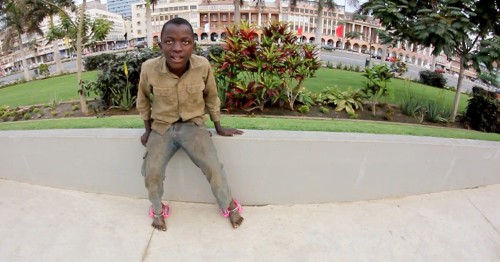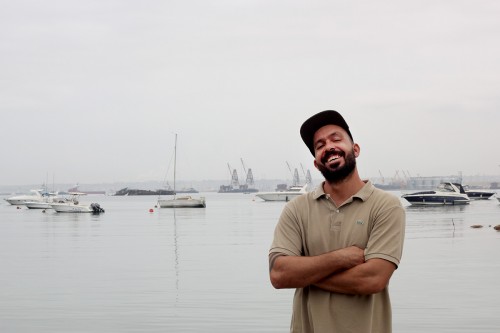Ricardo, there’s a couple reasons this whole interview is crazy. I guess the first is that your main focus for the past couple years hasn’t been blading — tell everyone what you’ve been doing.
Ah, ha ha, you’re right — it’s kinda crazy how a simple trip turns so special. As for my main focus, it has always been rollerblading and it will always be. I’ve been skating for over 30 years and you can’t just put something else in front of it. I have been riding bikes a lot during the last three or four years. I had too many ankle injuries while blading full time and right now I just can’t handle any serious impacts. But in bikes I found the adrenalin I need to live, but he — a rollerblader’s heart will always be a rollerblader’s heart, no matter what!
Anyway, I’ve been really successful with this fixedgear freestyle bikes thing, and soon I’m going to have one of the first signature fixedgear freestyle frames in the industry.
Another crazy thing is just the setting of this tale — Angola, Africa. When you first gave me the scoop you said “its like if they we´re europe or USA in 96…its crazy how many kids ride them blades in there….most of them dont have agressive skates..or even acess to internet to know what other people do with rollerblades..BUT they they all fuckin love it and we made ZILIONS of friends…” How is that possible? At the risk of sounding unnecessarily skeptical, why are kids in Africa riding around on blades?
It’s really weird how this happens in a country 20 years late, but back when we used to skate with all our classmates these guys were living in a war. Their country needed time to start the reconstruction after the war. It was only about three years ago that they started having smooth surfaces where they could skate.
What you have in Luanda (the Capital of Angola) right now is a city with the capacity for 1 million citizens but there’s approximately 6 million living there. Now imagine how many kids live there and imagine how many of them want to join the “cool ones” and rollerblade.
Let’s back up a bit and tell everyone how you ended up blading in Africa.
I studied sports science and for the last two years have been working for a company owned by rollerbladers called “ACADEMIA DOS PATINS.” What we do is to plan and build skateparks, organize extreme sport events, and teach kids all kinds of extreme sports. This whole thing is amazing for a guy who lived the Blade Life forever but who still feels sad when I go to a skatepark and see only small groups of rollerbladers — even if I know I’m doing my part to change it.
This project started just like any other event we do — we had an agency contact us saying they wanted to do an extreme sports event, but this time in Luanda. We thought just like every other agency in every other country they would want skateboarders and bikers, but when asked they told us right away, “NO, there’s no skateboarders or bikers here. The cool thing right here is rollerblading, all kids love it.” Words just can’t express how I felt hearing that. My brain started working right away on the idea to show the world and the industry we are FAR FROM BEING DEAD!
So is the facility you developed the space we see in the trailer? Tell us about the project.
Yeah, we installed a skatepark in Luanda. It will be in Luanda Bay until November and by the then by mid-November we’re traveling there again to move it to another part of the city. But during that second trip we’ve got meetings set up with the important-type people over there to discuss building more facilities where the kids can practice.

Let’s talk about the kids, because they are having so much fun. What was it like hanging out with everyone? Were any of the skaters doing tricks in the edit locals?
In the final video you will see a couple of locals doing tricks and let me tell you, boy are they fearless. I taught a kid to do quarterpipe backflips in two minutes. It’s crazy how much control they have over those skates and I’m sure they’ll be really good soon.
What access to equipment do the skaters have? Where do they get their skates?
Some of them, a few, have their parents traveling a lot and have access to rollerblades from Europe or from the USA, but most of them have Chinese cheap-ass skates they buy on the street, witch is another crazy thing. In Luanda you see people selling drinks on the streets, food, sunglasses, and ROLLERBLADES.
I’m currently trying to make connections in Luanda to find people that can work to import rollerblade equipment over there. So if you’re reading this, and you wanna be part of this, just get in contact with me.
Do you imagine that their scene will continue to develop, maybe more quickly now that they’ve seen what’s possible thanks to you and this project?
Man, if they continue to develop it won’t be just because of me. We’re a team of four guys: me, Samuel Dias, Bernardo Oliveira and Pedro Ferraz. We’ve we all skated for over 15 years and put our hearts into something we really love. But yes, I really think these kids will progress fast ’cause just like I told you before, most of them don’t know tricks names or whatever but they have such an amazing skate control. And some of them have access to the internet, and we all know how much the internet will help their progression too.

What did you learn about people from meeting all the kids?
My biggest lesson was “people are stronger then we think.” I never really thought the “want” was so powerful, but over there in Luanda I saw, like, five kids sharing a pair of rollerblades. Or even kids using skates without front wheels or real wheels, ’cause the frames were broken, but that wouldn’t make them stop doing what they love.
I saw a lot of boys. Are there girls on skates down there?
Hell yeah! I’m not gonna tell you it’s 50/50, but we saw a lot of girls rollerblading there too.
Was there much to street skate where you were, or is it limited to a few developed places in the urban centers?
I know there’s a lot of construction work in the city, but we didn’t really get too far into other parts of the city, mostly because Luanda is a really pretty city, but also really dangerous. There are a lot of parts in the city where you just can’t go by yourself. We mostly got to skate the bay area, which is all-new and PERFECT for skating. We also saw a couple of really nice spots. The locals told us about some other nice spots we didn’t get to, but hey, I’m gonna be back there soon so my search will continue…
How did the locals respond to your blading? I’m sure they were impressed!
I think they like to have us there. We taught them, we did demos, we organized a small competition, and in the end we invited the top three to do the final demos with us.
Ha ha, they were impressed mostly with the flips and that kind of stuff, but that’s normal. Most of them couldn’t understand the tech tricks yet. But most of all I felt the respect from those kids and that meant a lot to me. It’s hard to understand, but a lot of those kids never had a teacher in life, and for them it was really hard to be quiet and listen sometimes. But on the last day we were there, I was able to organize a race with more then 120 kids, without a microphone! They were all quiet and patient while they listened to the rules.

What was the most surprising or unexpected moment or experience of your trip?
Simply the BEST moment of this trip was meeting this kid called “Lido,” an 8- or 9-year-old kid we found laying down on the streets with two pink things in his hands. He wouldn’t talk with us at first, but I kept trying to talk with him and every time I landed a trick I’d ask him to clap his hands. Later that day I saw that those pink things he had in his hands were some of those wheels kids put under their shoes to roll, but he didn’t have shoes and strapped those things directly in his feet with a little bit of plastic bag. He was all dirty and later that day someone told me Lido lived in the street, drinks lots of alcohol and sniffs glue everyday. Three days later little Lido came to the event and I taught him to rollerblade with proper skates we had for kids to try. The next day I managed to give him a pair of skates but they were stolen from him a few days later. We started talking a little more and we could see his interest was in rollerblading — he wasn’t thinking about alcohol, glue or whatever. He would be the first at the event every day and learn a little more rollerblading.
One day I told him, “Lido, you gotta take baths or people won’t like you the same way” and from that day on he would go to the ocean every morning, wash himself and his clothes, then meet us later when he was all cleaned up.
For me, this was one of the best moments of my life. Even if I don’t know how Lido is doing right now, just knowing what rollerblading can do for an African street kid means a lot to me.

Wow Ricardo, that’s incredible! We’re very proud to have such a great person like you out there doing the blade missionary work. So let’s call it a wrap for now. The trip sounded so amazing and we can’t wait to see the full documentary. Let us know if there’s anything we can do!
I’m the one saying thanks, Justin — you did a lot already. Thanks, ONE.
That is simply Awsome!!! Great job!!!!
La verdad que felicidades, es impresionante el trabajo que han realizado allí, y lo que aún queda. Un saludo desde Málaga-España.
beautiful shared experience
Had my mind blown.